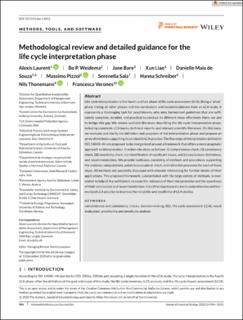Methodological review and detailed guidance for the life cycle interpretation phase
| dc.contributor.author | Laurent, Alexis | |
| dc.contributor.author | Weidema, Bo Pedersen | |
| dc.contributor.author | Bare, Jane | |
| dc.contributor.author | Liao, Xun | |
| dc.contributor.author | Maia de Souza, Danielle | |
| dc.contributor.author | Pizzol, Massimo | |
| dc.contributor.author | Sala, Serenella | |
| dc.contributor.author | Schreiber, Hanna | |
| dc.contributor.author | Thonemann, Nils | |
| dc.contributor.author | Verones, Francesca | |
| dc.date.accessioned | 2021-02-22T12:29:08Z | |
| dc.date.available | 2021-02-22T12:29:08Z | |
| dc.date.created | 2020-05-20T17:12:21Z | |
| dc.date.issued | 2020 | |
| dc.identifier.citation | Journal of Industrial Ecology. 2020, 24 (5), 986-1003. | en_US |
| dc.identifier.issn | 1088-1980 | |
| dc.identifier.uri | https://hdl.handle.net/11250/2729514 | |
| dc.description.abstract | Life cycle interpretation is the fourth and last phase of life cycle assessment (LCA). Being a “pivot” phase linking all other phases and the conclusions and recommendations from an LCA study, it represents a challenging task for practitioners, who miss harmonized guidelines that are sufficiently complete, detailed, and practical to conduct its different steps effectively. Here, we aim to bridge this gap. We review available literature describing the life cycle interpretation phase, including standards, LCA books, technical reports, and relevant scientific literature. On this basis, we evaluate and clarify the definition and purposes of the interpretation phase and propose an array of methods supporting its conduct in LCA practice. The five steps of interpretation defined in ISO 14040–44 are proposed to be reorganized around a framework that offers a more pragmatic approach to interpretation. It orders the steps as follows: (i) completeness check, (ii) consistency check, (iii) sensitivity check, (iv) identification of significant issues, and (v) conclusions, limitations, and recommendations. We provide toolboxes, consisting of methods and procedures supporting the analyses, computations, points to evaluate or check, and reflective processes for each of these steps. All methods are succinctly discussed with relevant referencing for further details of their applications. This proposed framework, substantiated with the large variety of methods, is envisioned to help LCA practitioners increase the relevance of their interpretation and the soundness of their conclusions and recommendations. It is a first step toward a more comprehensive and harmonized LCA practice to improve the reliability and credibility of LCA studies. | en_US |
| dc.language.iso | eng | en_US |
| dc.publisher | Wiley | en_US |
| dc.rights | Attribution-NonCommercial-NoDerivatives 4.0 Internasjonal | * |
| dc.rights.uri | http://creativecommons.org/licenses/by-nc-nd/4.0/deed.no | * |
| dc.title | Methodological review and detailed guidance for the life cycle interpretation phase | en_US |
| dc.type | Peer reviewed | en_US |
| dc.type | Journal article | en_US |
| dc.description.version | publishedVersion | en_US |
| dc.source.pagenumber | 986-1003 | en_US |
| dc.source.volume | 24 | en_US |
| dc.source.journal | Journal of Industrial Ecology | en_US |
| dc.source.issue | 5 | en_US |
| dc.identifier.doi | 10.1111/jiec.13012 | |
| dc.identifier.cristin | 1811992 | |
| dc.description.localcode | © 2020 The Authors. Journal of Industrial Ecology published by Wiley Periodicals LLC on behalf of Yale University This is an open access article under the terms of the Creative Commons Attribution‐NonCommercial‐NoDerivs License, which permits use and distribution in any medium, provided the original work is properly cited, the use is non‐commercial and no modifications or adaptations are made. | en_US |
| cristin.ispublished | true | |
| cristin.fulltext | original | |
| cristin.qualitycode | 2 |

